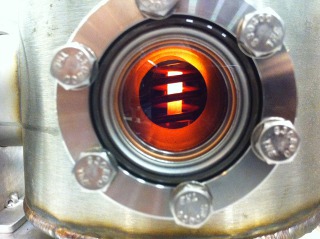 |
| January 16, 2018 | Volume 14 Issue 02 |
Designfax weekly eMagazine
Archives
Partners
Manufacturing Center
Product Spotlight
Modern Applications News
Metalworking Ideas For
Today's Job Shops
Tooling and Production
Strategies for large
metalworking plants
Feel the 2X power: NASA contracts with BWXT Nuclear Energy to advance nuclear rocket-propulsion technology
As NASA pursues innovative, cost-effective alternatives to conventional propulsion technologies to forge new paths into the solar system, researchers at NASA's Marshall Space Flight Center in Huntsville, AL, say nuclear thermal propulsion technologies are more promising than ever, and have contracted with BWXT Nuclear Energy of Lynchburg, VA, to further advance and refine those concepts.

Non-nuclear testing of fuel element materials is an affordable approach to Nuclear Thermal Propulsion engine development. This is a Compact Fuel Element Environmental Test (CFEET) System at Marshall Space Flight Center.
Part of NASA's Game Changing Development Program, the Nuclear Thermal Propulsion (NTP) project could significantly change space travel, largely due to its ability to accelerate a large amount of propellant out of the back of a rocket at very high speeds, resulting in a highly efficient, high-thrust engine. In comparison, a nuclear thermal rocket has double the propulsion efficiency of the Space Shuttle main engine, one of the hardest-working standard chemical engines of the past 40 years. That capability makes nuclear thermal propulsion ideal for delivering large, automated payloads to distant worlds.
"As we push out into the solar system, nuclear propulsion may offer the only truly viable technology option to extend human reach to the surface of Mars and to worlds beyond," said Sonny Mitchell, Nuclear Thermal Propulsion project manager at Marshall. "We're excited to be working on technologies that could open up deep space for human exploration."
Nuclear-powered rocket concepts are not new. The United States conducted studies and significant ground tests from 1955 to 1972 to determine the viability of such systems, but ceased testing when plans for a crewed Mars mission were deferred. Since then, nuclear thermal propulsion has been revisited several times in conceptual mission studies and technology feasibility projects. But to date, all nuclear propulsion system designs have been derived from reactors fueled by highly enriched uranium. Thanks to renewed interest in exploring the Red Planet in recent decades, NASA has begun new studies of nuclear thermal propulsion, recognizing its potential value for exploration of Mars and beyond.
An NTP system can cut the voyage time to Mars from six months to four and safely deliver human explorers by reducing their exposure to radiation. That also could reduce the vehicle mass, enabling deep space missions to haul more payload.
VIDEO: See how Nuclear Thermal Propulsion (NTP) works.
Given its experience in developing and delivering nuclear fuels for the U.S. Navy, BWXT will aid in the design and testing of a promising, low-enriched uranium-based nuclear thermal engine concept and "Cermet" (ceramic metallic) fuel element technology. During this three-year, $18.8-million contract, the company will manufacture and test prototype fuel elements and also help NASA properly address and resolve nuclear licensing and regulatory requirements. BWXT will aid NASA in refining the feasibility and affordability of developing a nuclear thermal propulsion engine, delivering the technical and programmatic data needed to determine how to implement this promising technology in years to come.
In late September, the Nuclear Thermal Propulsion project will determine the feasibility of using low-enriched uranium fuel. The project then will spend a year testing and refining its ability to manufacture the necessary Cermet fuel elements. Testing of full-length fuel rods will be conducted using a unique Marshall test facility.
The company's new contract is expected to run through Sept. 30, 2019.
The Nuclear Thermal Propulsion project is managed by NASA's Game Changing Development Program, part of the agency's Space Technology Mission Directorate.
For more about NASA's Nuclear Thermal Propulsion project, we highly recommend you download this resource: https://gameon.nasa.gov/gcd/files/2016/05/FS_NTP_160525.pdf.
Source: NASA
Published August 2017
Rate this article
View our terms of use and privacy policy
